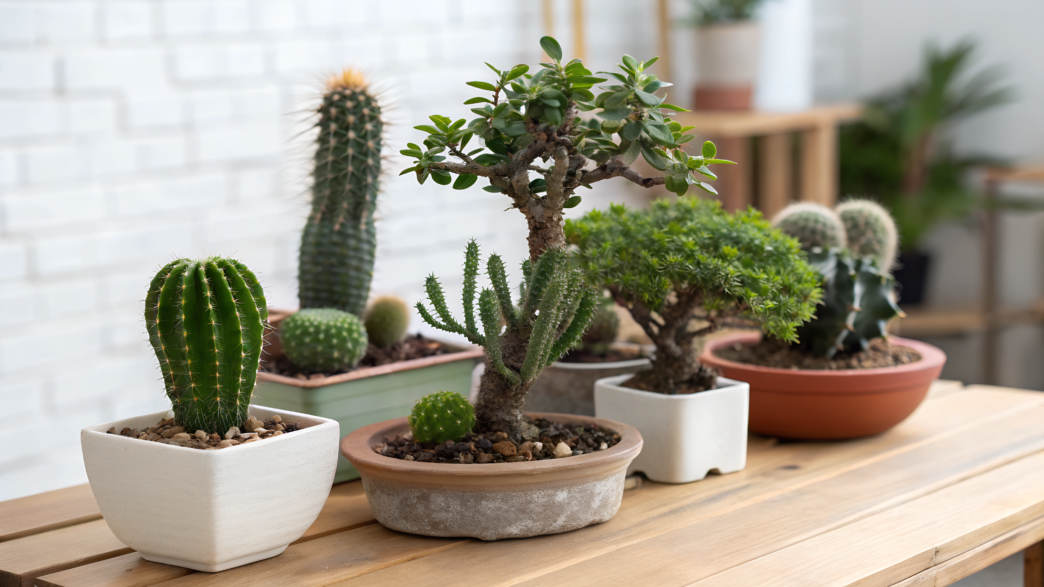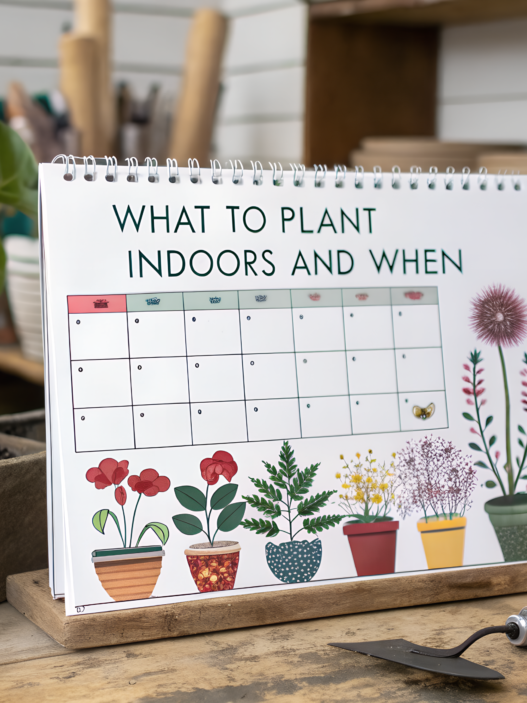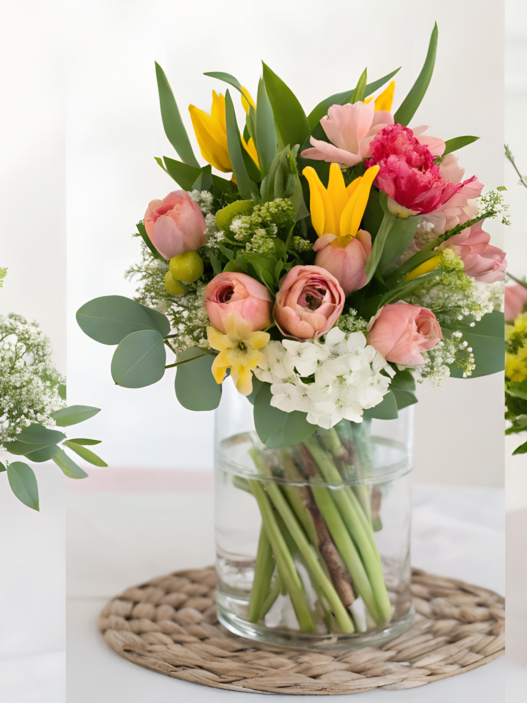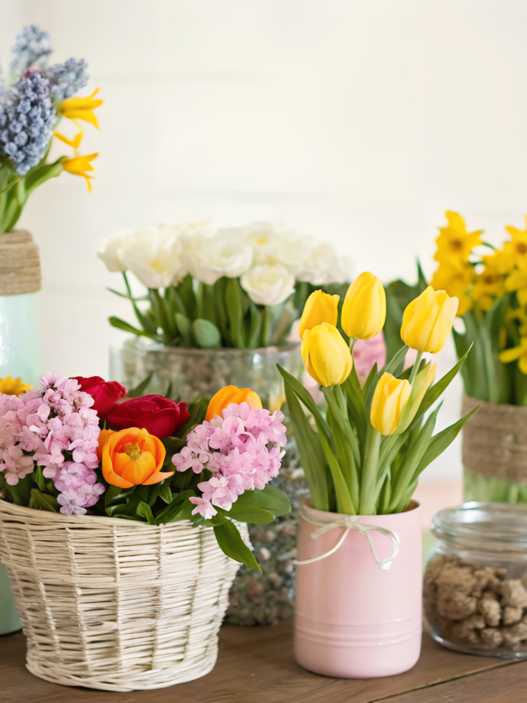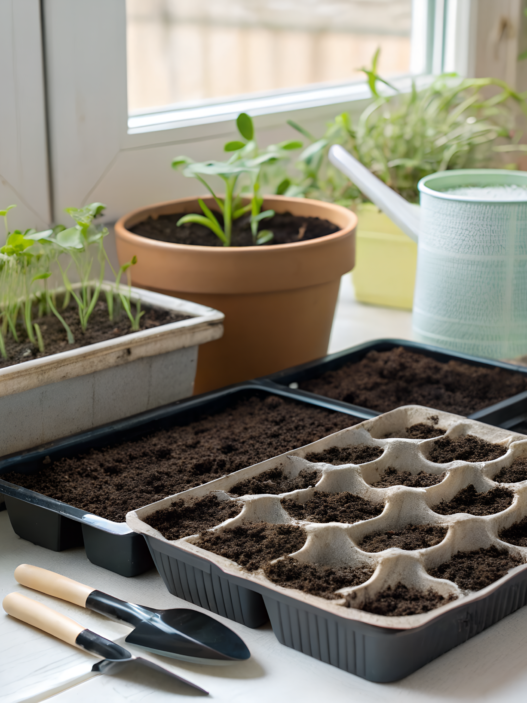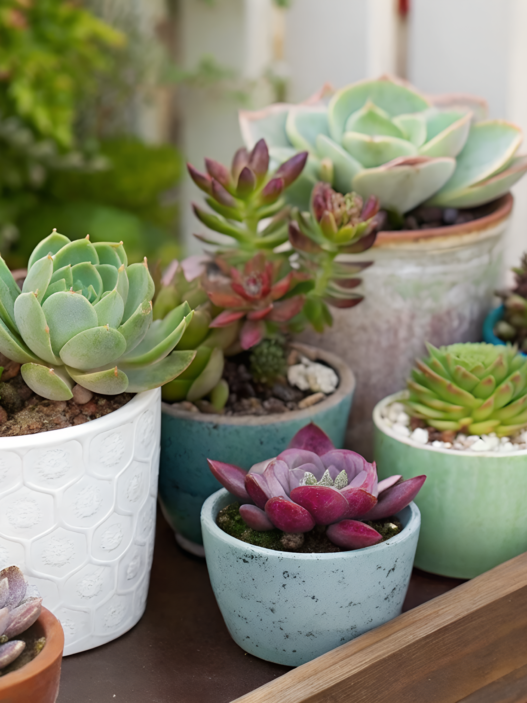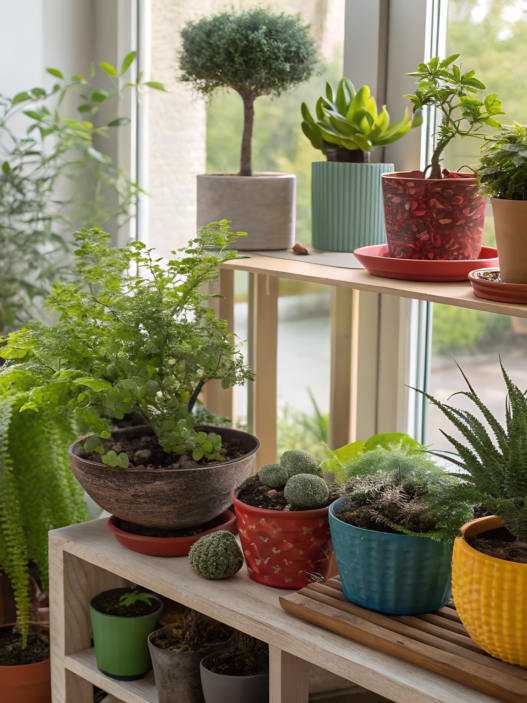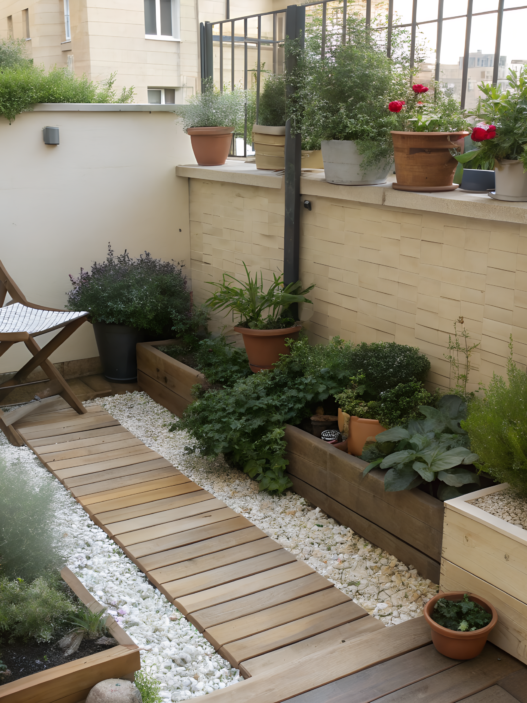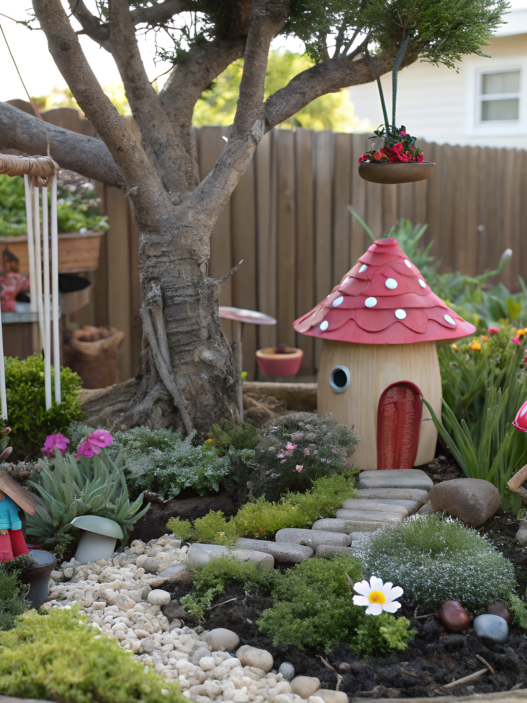If you love live plants but aren’t ready to spend half your life with a watering can, mini gardens are the answer. They do not require complicated care, easily fit into any interior and look simply amazing.
Today I will try to tell you about 6 variants of mini gardens with cacti, bonsai and succulents. And imagine that some of them are completely self-watering (yes, yes, there are such things!), and others take up a minimum of space, but at the same time create maximum pleasure from the presence of a green corner with live plants in your home.
Make a Mini Indoor Cactus Garden That Waters Itself (No Maintenance!)
1. Self-watering mini indoor cactus garden in a glass jar
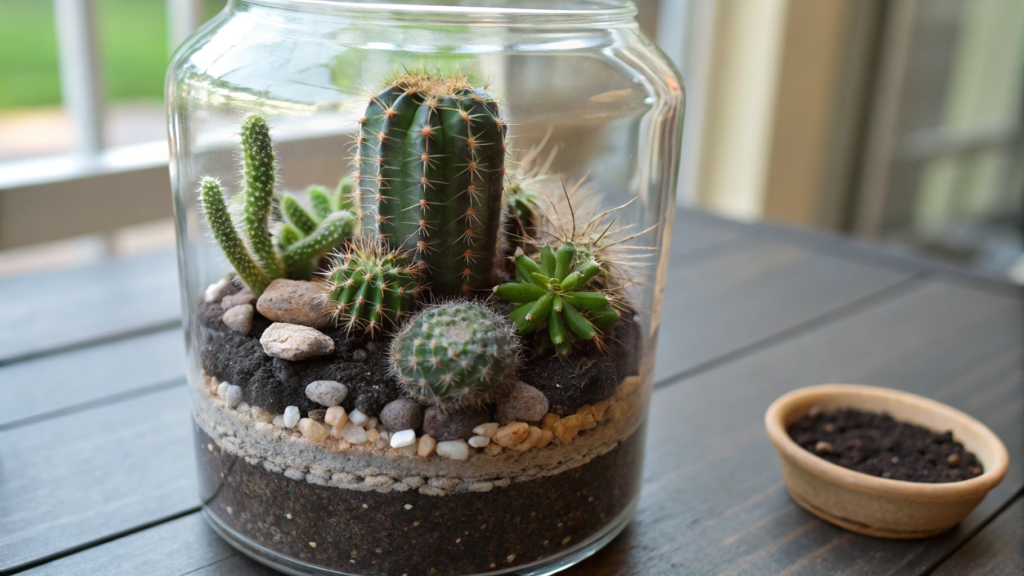
Have you ever heard that plants can water themselves? See if you haven’t! This self-watering garden is perfect for those who often forget to take care of their plants (or just don’t want to bother). And a little bonus – thanks to the glass jar, you’ll be able to watch the roots grow, turning this garden into a little science experiment. Interesting, isn’t it!
What you’ll need:
- A large glass jar or terrarium (wide-mouth is best) – Check out this one on Amazon
- Mini cacti (Gymnocalycium, Mammillaria or Fairy Castle)
- Cactus soil (regular soil holds too much moisture)
- Small pebbles and activated charcoal (prevents rotting)
- Self-watering wick or cotton rope (carries moisture to the roots)
- A hidden water reservoir (such as a small bowl under a layer of soil)
How to make:
- Create a drainage layer. Put pebbles and activated charcoal at the bottom of the jar – they will absorb excess moisture and protect the roots from rotting.
- Install a self-watering system. Run a wick or cotton rope through the drainage layer so that one end is in the water tank and the other end is in the soil. This will allow the moisture to gradually rise, supplying the roots with exactly the amount of water they need.
- Add soil and cacti. Fill the jar with cactus soil, leaving some space at the top. Then carefully plant the plants, pressing the soil lightly at the roots.
- Add pebbles on top. Note that not only will this make the garden aesthetically pleasing, but it will also help retain moisture for longer.
- Water once and forget it!. Pour a little water into the hidden reservoir and that’s it! The wick will pull moisture to the roots as needed.
That’s it, you now have a mini desert in a jar that takes care of itself!
Tip. Use a jar with a wide neck so that the plants get more air and condensation does not accumulate.
2. Cactus mini gardens with hidden water tank
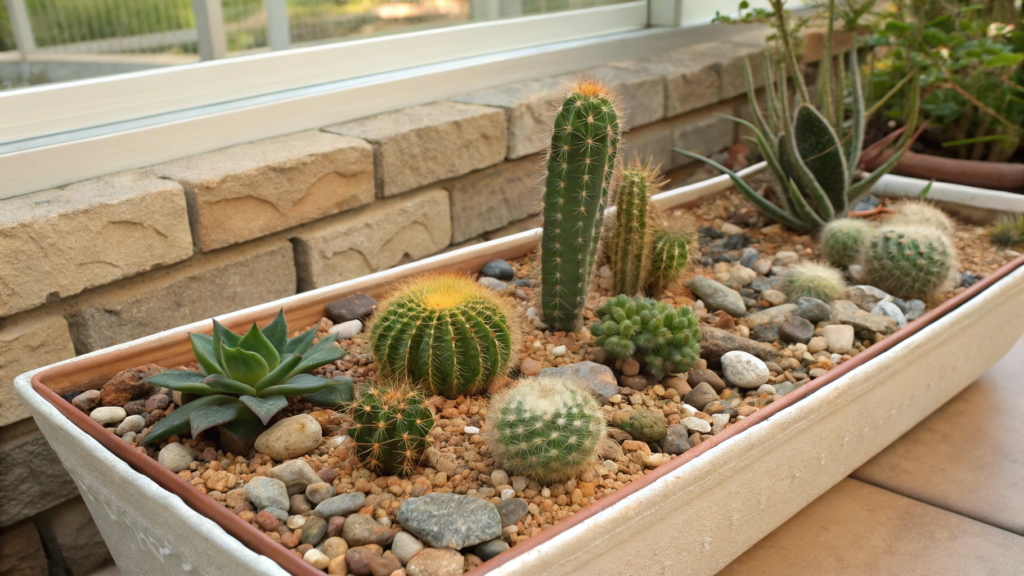
Watering plants, as we know, is always a balance between “too much” and “too little”. What if we finally stop guessing and create a mini garden at home with a built-in water tank that does it all for you?
What you’ll need:
- A shallow ceramic or plastic container (with room for water at the bottom)
- A mix of small cacti (Golden Ball, Prickly Pear, Echinopsis)
- Perlite or small pebbles (for good drainage)
- Self-watering spikes or hydrospikes (slowly release water)
- Decorative pebbles (for a finished look)
How to make:
- Create a drainage layer. Fill the bottom with perlite or pebbles to keep the roots from sinking in water.
- Place the cacti. Take the cacti out of their pots, gently shake off excess soil. Combine different heights and shapes, this will help create a beautiful “landscape”.
- Insert self-watering spikes. This is where the fun part starts! The spikes slowly, gradually deliver water to the roots, so you can relax and forget about watering for a few weeks.
- Add soil and pebbles on top. Sprinkle soil on top, tamp it down a little, then decorate with decorative pebbles.
There you go, fill the tank and let the spikes do their job. This setup is just right for those who travel a lot or simply forget to water their plants.
Tip. Rotate the tank every couple weeks to keep the cacti growing evenly!
Quick and Simple Mini Garden Idea: Combine Cactus and Bonsai Indoors
3. Minimalistic Japanese-style bonsai and cactus garden
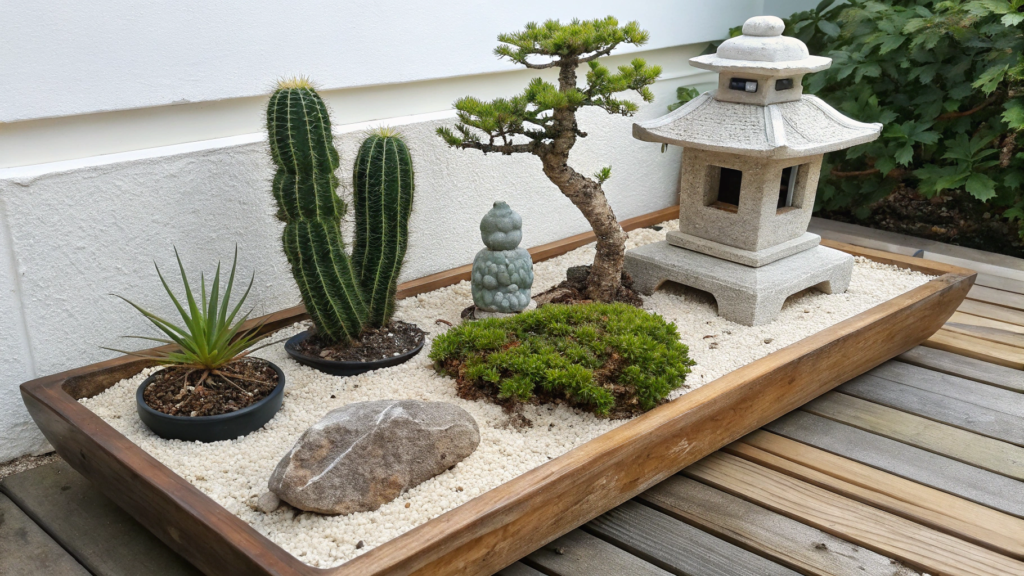
Once a day we all dream of finding ourselves in a tranquil place that is pleasing to the eye, calming to the nerves and not too time-consuming to maintain. This Japanese-inspired mini garden combines the structured beauty of bonsai with the unpretentiousness of cacti to create the perfect balance between greenery and the harsh desert aesthetic.
What you’ll need:
- A shallow rectangular tray (ceramic, wood or stone)
- Mini-bonsai (ficus or juniper are great options for beginners)
- Small cacti (Haworthia or Astrophytum will add texture)
- Small gravel, sand or decorative stones
- A miniature pagoda, Buddha or stone lantern (optional, but will help give the garden a Japanese charm)
How to make:
- Fill the base with gravel or sand. This will create a natural base similar to traditional Japanese gardens.
- Place the bonsai. Bury the mini bonsai pot halfway into the sand or gravel. Place it slightly sideways to make the composition look natural and asymmetrical. Surround it with rocks or small gravel to create a smooth transition effect from the bonsai to the composition.
- Add small cacti. Arrange them in different places, imitating a mountainous landscape.
- Decorate with details. Lay out stone paths or a small pagoda, for a touch of Japanese garden style.
A minimalist Japanese-style garden can give any space an elegant Zen touch.
Tip. Use a mini rake to make patterns in the sand, it’s really relaxing.
4. Mini terrarium with bonsai and cacti
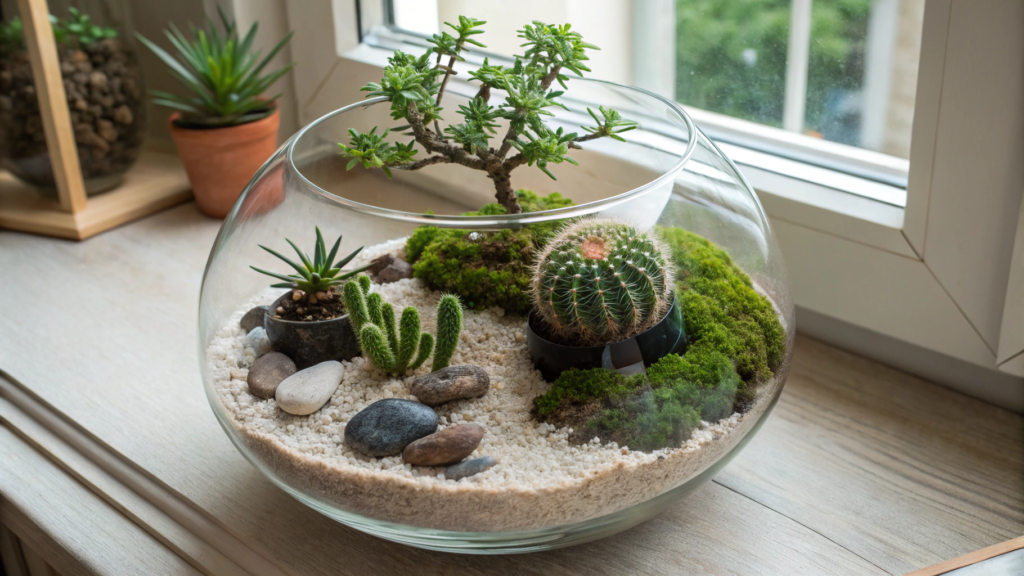
Imagine you’ve managed to create a small world in a glass ball. This combination of mini bonsai and desert cacti creates a self-sufficient micro-system, which can be placed both in the office and in a cozy corner of the house. And in both cases, they’ll blend in beautifully with the proposed decor.
What you’ll need:
- A large glass bowl or terrarium
- Mini Bonsai (Dwarf Jade or Fukien Tree)
- Desert type cacti (Cholla, Astrophytum, Old Cactus)
- Sand, moss and decorative stones
How to make:
- Create a drainage layer. Fill the bottom with sand and small pebbles to keep the roots from rotting.
- Plant bonsai and cacti. Place the bonsai a little to the side, placing low cacti nearby for contrast.
- Add moss and rocks. This will give the terrarium a natural look and add texture.
- Light watering and shelter (optional). If the terrarium is covered, lightly spray the soil once a week to create a natural moisture cycle.
Try doing this and you’ll find you’ll love this tiny green corner in the glass.
Tip. Position your terrarium so that bright but diffused light falls on it. This will help prevent condensation from forming.
DIY Indoor Succulent mini Gardens for Small Spaces
5. Vertical garden of succulents in a frame
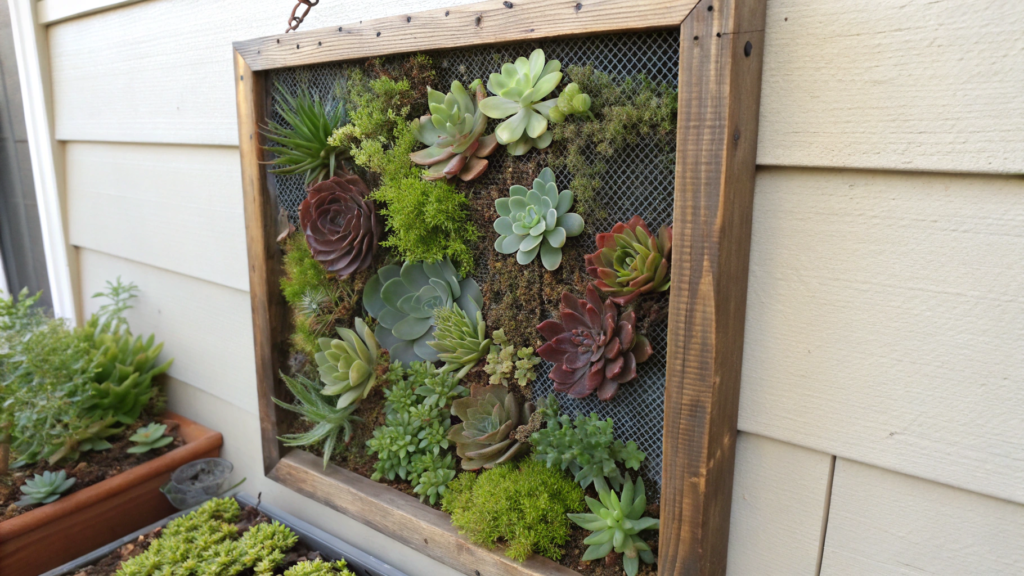
A succulent frame allows you to grow plants on the wall, which looks unique while taking up no countertop space. This vertical succulent garden turns plants into wall art.
What you’ll need:
- Shade box frame (with mesh backing)
- Succulent cuttings (echeveria, crassula or sedum)
- Sphagnum moss (for moisture retention)
- Stapler or glue gun (for securing plants)
- Sprayer (for easy spraying)
How to make:
- Prepare the frame. If your frame doesn’t have a mesh backing, attach it with a stapler or glue gun. This will secure everything in place.
- Fill with moss. Moisten sphagnum moss and press it tightly against the frame – it will serve as a soil substitute.
- Plant succulents. Carefully insert succulent cuttings through the mesh, making sure they make good contact with the moss so they root properly.
- Let them root. Before hanging, leave the frame lying horizontally for 3-4 weeks to give the roots time to establish themselves.
- Place on the wall. Once the succulents have rooted, mount the frame on the wall or place it on a shelf.
You are now the owner of a stunning piece of living wall art. Congratulations!
Tip. Spray the plants once a week, as they have short roots.
6. Mini succulent garden in a tea cup
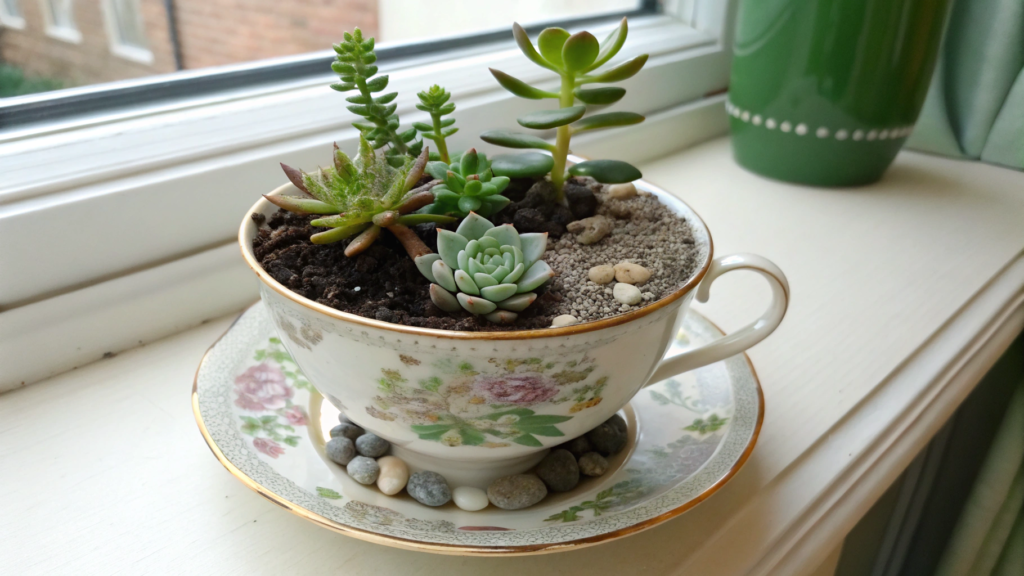
Here’s a pretty good idea to turn a cute vintage teacup found at a flea market into a tiny succulent garden. After all, this teacup is too beautiful to just stand in a cupboard!
This garden would be a lovely green accent for a desk, shelf, or windowsill.
What you’ll need:
- A tea cup or small ceramic pot (no drainage hole? No big deal, we’ll figure it out!)
- Mini succulents (Jade Tree, Ochitok or Threadleaf Portulaca)
- Soil for cacti and succulents (regular soil is too wet)
- Small decorative stones or sand (to keep the garden looking neat)
- A little activated charcoal (optional, but will help avoid excess moisture)
How to make:
- Prepare a cup. If the cup doesn’t have a drainage hole, pour a thin layer of activated charcoal in the bottom. It will absorb excess moisture and protect the roots from rotting.
- Add soil. Fill the cup with soil for succulents, leaving some space at the top.
- Plant the succulents. Carefully remove the plants from the pots, loosen the roots slightly with your fingers, and place them in the cup. If you’re using ampelike plants (such as Threadless Portulacus), let them hang loosely over the edge of the cup.
- Add decorative pebbles. This step will give the composition a more aesthetic look and help retain moisture in the soil.
- First watering. Water very wisely. It is better to use a spoon or pipette for dosage. On average, once every 2-3 weeks is quite enough!
Here we are ready! You only need to find a suitable place for a mini garden.
Tip. Create a mini collection of such gardens in several cups. Different colors and shapes will look especially spectacular.
Choosing a mini garden
With the right approach, cacti, bonsai and succulents can be enjoyed all year round without you spending a lot of time caring for them. Mini gardens in the home don’t have to be finicky! Which of these mini gardens is your favorite? Pick the right mini garden for you. Have you tried something like this? Share in the comments, I’m interested to hear what you think about it.

